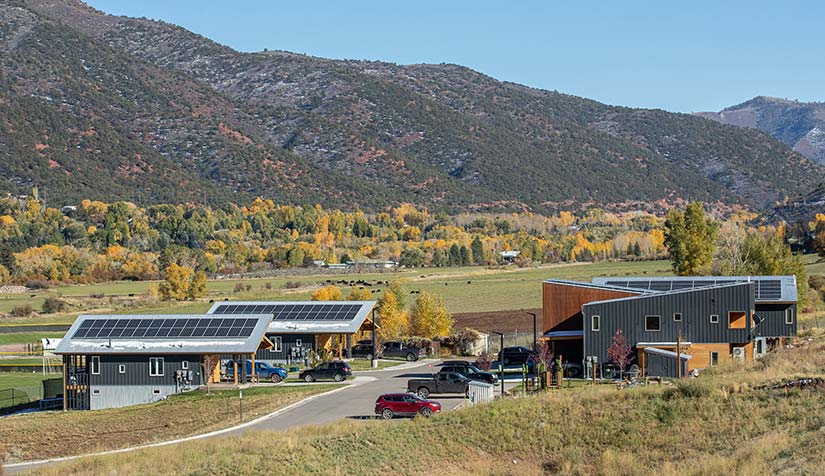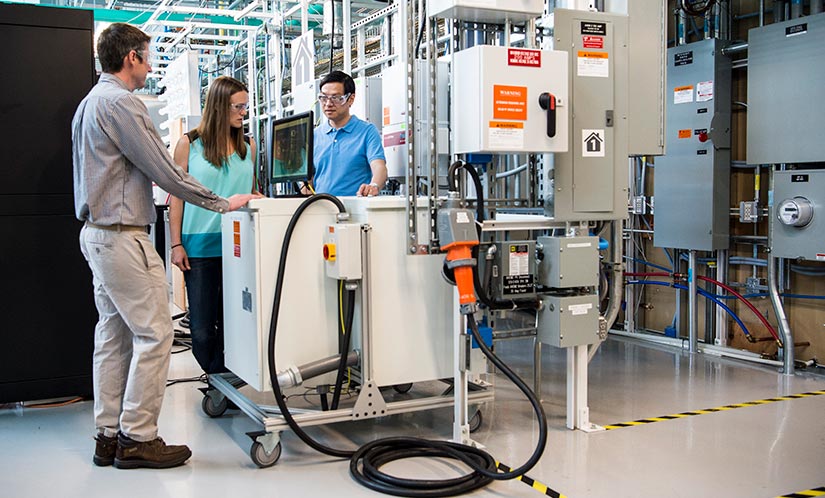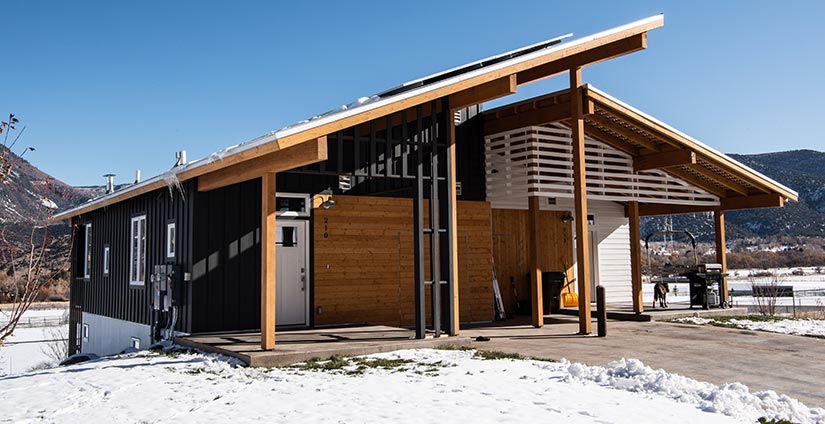Colorado Mountain Homes Prepare To Pilot Autonomous Energy Management
NREL Gets Ready To Perform Ground-Truth Evaluation of Artificial Intelligence for Equitable Decarbonization and Energy Savings

The Basalt Vista community, nestled high in the mountains in Basalt, Colorado, is about to get a whole lot smarter in the pursuit of energy efficiency and renewable energy integration.
The National Renewable Energy Laboratory (NREL) is installing its R&D 100 Award-winning foresee™ software in local homes to field-test smart energy management and community-level energy aggregation and coordination as part of its Smart Community project. The software will leverage physics-based modeling, machine-learning algorithms, and advanced data analytics to provide Basalt homeowners whole-home energy cost savings balanced with comfort, convenience, and grid benefits.
Participating families will allow cloud-based foresee to connect to hardware and Internet-of-Things devices throughout their homes. These include heating, ventilating, and air conditioning systems, water heaters, solar photovoltaic, home battery systems, electric vehicle charging stations, wireless energy monitors, and smart water monitors. The energy management software, hosted on Amazon Web Services, will autonomously coordinate building loads with photovoltaic generation, battery storage, and the electrical grid while fulfilling occupant preferences related to energy savings, comfort, and reducing carbon dioxide emissions. Additionally, a cloud-based aggregator will coordinate among multiple buildings to manage energy resources across the community.
Autonomous Energy Management Enters Real Homes
After spending several years evaluating and refining the systems inside of NREL labs, lead researcher Xin Jin said he is "really curious to see the performance of foresee and the aggregator in the real world. Although we've tried to create models that are as close as possible to these homes, there are some elements, such as human behavior and occupancy, that are challenging to model. We're excited to see how these uncertainties affect actual performance."
Rock-Solid Basalt Partnerships
The Basalt Vista pilot is founded on a bedrock of local and national partnerships. The smart community field demonstration is co-funded by U.S. Department of Energy Solar Energy Technologies and Building Technologies offices. Local partners include electric cooperative Holy Cross Energy and Habitat for Humanity Roaring Fork Valley.
NREL has partnered with Holy Cross Energy and the Basalt Vista community on several previous projects. Holy Cross's chief executive officer was a prior associate laboratory director of Energy Systems Integration at NREL, and the unique energy needs and geographic restraints of the mountain community present a valuable test bed for innovative approaches to resilient, sustainable energy management. As Basalt is 3 1/2 hours away from NREL, Holy Cross Energy also serves as an important bridge to the community for recruitment.
Habitat for Humanity is another key partner for homeowner outreach. As the homebuilder of the Basalt Vista community, the Habitat team is familiar with each home's configuration and every single homeowner—local schoolteachers and other workforce members who participated in the building of these affordable homes—and encouraged them to sign up for the pilot. NREL will share outcomes from the pilot with Habitat, for whom sustainable and resilient affordable housing is mission-critical.
Other partners include Copper and Conservation Labs, who supported the field demonstration by providing advanced sensing technologies that enable some of the key functionalities of the autonomous energy management system. Copper's wireless energy monitors provide not only high-resolution energy consumption data but also voltage measurements from each home and service transformer in real time. These data are used by the autonomous energy management system to update its control actions and ensure safe operation of the distribution grid. Conservation Labs' H2know smart water monitor, a nonintrusive solution to measure a home's water consumption, provides necessary data to foresee artificial intelligence algorithms for identifying water usage patterns and behavior changes in a home.

Project Origins in NREL's Systems Performance Lab
Researchers emphasized that lab work and field work are by no means separate efforts. Well before bringing the technology to Basalt, researchers performed extensive experimentation in the laboratory setting to de-risk the system before taking it to the field. Research engineer Bethany Sparn describes a progression from concept to field validation: "The first year of the project was used to develop control algorithms based on simulated buildings. In the second year, we took those models into the lab with real equipment to identify integration challenges or hardware compatibility issues—and we worked out those kinks in the lab rather than in peoples' homes."
NREL's Systems Performance Laboratory infrastructure allowed researchers to perform hardware-in-the-loop experimentation to run a model of a home while imitating climate conditions. The team used the lab to evaluate different control strategies based on the hardware found in the Basalt homes, while performing a building-to-grid co-simulation using NREL's Eagle supercomputer.
With hardware kinks out of the way, Sparn said, the research in Basalt can focus on the actual control strategies. "We can validate the overall goal of the project as opposed to working through all of the physical challenges that often come up on this type of project."

Within the Basalt Vista neighborhood in Basalt's rugged foothills, NREL is testing one of its most novel grid operation solutions with the customers of Holy Cross Energy, the local electric cooperative. The affordable housing development features some of the most energy efficient residential homes ever built, all controlled by computers as part of an autonomous grid. Photo by Dennis Schroeder, NREL
Artificial Intelligence Manages Home Energy According to Owner Priorities
NREL's foresee performs autonomous energy management based on stated homeowner preferences:
- If owners rank comfort highest, the system will maintain indoor temperatures as close as possible to the owner’s ideal.
- If the owner is willing to sacrifice some comfort to lower their utility bills, the system will let temperatures fluctuate a bit more in hot or cold weather.
- If the owner’s first priority is to reduce carbon dioxide emissions, foresee will reduce the home’s energy use when the grid is using more carbon-intensive energy sources such as coal.
Autonomous Energy Management in the Real World
During the initial deployment phase, research staff will meet with owners to identify their preferences, including their preferred cooling and heating temperatures as well as their ranked priorities, including saving energy, reducing energy bills, or comfort. Once in operation, the autonomous energy management system will make decisions based on those specified preferences.
If the field demonstration is successful, the participating homeowners will not even notice—except perhaps on their lowered energy bill. According to Jin, "Our goal is to make the system work behind the scenes."
The Big Picture: Energy Equity and Decarbonization
Beyond immediate hopes for more comfortable, energy-efficient homes and communities, the Smart Community project fulfills two key energy priorities: equity and decarbonization. The field demonstration brings breakthrough energy management technologies straight from a national laboratory to a low-income community—Basalt Vista homes were built as affordable housing for the local workforce.
Jin is optimistic that the benefits will extend far beyond the Colorado mountains: "Hopefully we can create a template for future projects to work with even more low-income communities."
Learn more about NREL buildings research.

